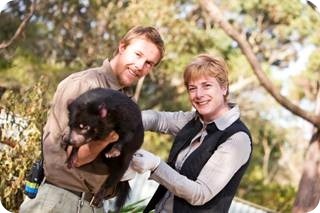 Cancer researchers have generated a genetic blueprint of the Tasmanian Devil genome, revealing cancer-associated genes that may answer important questions about adult and childhood cancer.
Cancer researchers have generated a genetic blueprint of the Tasmanian Devil genome, revealing cancer-associated genes that may answer important questions about adult and childhood cancer.
In a world-first breakthrough, Dr Vanessa Hayes, who began her research on this project as Leader of the Cancer Genetics Group, Children’s Cancer Institute Australia (CCIA), at the Lowy Cancer Research Centre UNSW, together with collaborators from Penn State University and her new colleagues at the J. Craig Venter Institute, have used cutting-edge DNA sequencing technology to successfully sequence and assemble the genomes of two Tasmanian Devils, Cedric and Spirit, who have a rare facial tumour.
The Tasmanian Devil is on the brink of extinction because of the this rare infectious cancer, called Devil Facial Tumour Disease. The cancer was first reported in 1996 and has swept across the island of Tasmania, resulting in a population decline of around 80%. As well as providing important clues to understanding cancer biology, this research could provide the essential tools to facilitate continued survival of a native Australian species from extinction.
Comparing the Tasmanian Devil’s own genetic material (genome) with genetic sequences from the tumour (generated by Australian biotech company GeneWorks), Dr Hayes and her collaborators have identified 139 target genes that are potentially associated with cancer in the Tasmanian Devil and may also be relevant in humans cancers.
“Devil Facial Tumour Disease is one of only two cancers found in nature that is infectious. These highly aggressive tumours, which erode the face, make it impossible to feed, and the animals die within six months. Initially it was thought this disease was caused by a virus, but now we know that it’s the cancer cells themselves that are transferred from animal to animal,” says Dr Hayes.
Although infectious cancers have not been reported in humans yet, Dr Hayes says we need to better understand this type of cancer.
The next step is to use the Tasmanian Devil genome to better understand this unique and highly aggressive cancer, and to identify breeding strategies that will protect this Australian icon from its predicted extinction by 2030.
Dr Hayes hopes that unlocking the secrets of this unique cancer affecting the Tasmanian Devil will provide new understanding of adult and childhood cancer.
“This research is likely to have far reaching implications for both childhood and adult cancer research, making it an invaluable contribution to Children’s Cancer Institute Australia’s vision of saving the lives of all children with cancer,” says Dr Hayes.
“Researchers can use the data generated from the genome and tumor sequence as a unique model organism to understand their favourite cancer-related gene. As scientists we have and continue to use model organisms to understand disease, like human cancers. We are opening the doors for other cancer researchers, who we will hope will benefit significantly from this research.”
The results of the Tasmanian Devil Sequencing Project have been published as a peer-reviewed paper in the Proceedings of the National Academy of Sciences. It can be viewed here: http://www.pnas.org/content/early/2011/06/23/1102838108.abstract
Background
Children’s cancer
As recently as the 1950s, childhood cancer was virtually a death sentence. Medical research has developed treatments to improve current childhood cancer survival rates to well over 70%. Even so, more than 600 Australian children will be diagnosed with cancer this year, and 120 will die of the disease this year. The long-term impact of child cancer on individuals, families and communities imposes a significant health, social and economic burden in Australia.
Children’s Cancer Institute Australia (CCIA)
Children’s Cancer Institute Australia for Medical Research (CCIA) is the only independent medical research institute in Australia devoted to research into the causes, better treatments, prevention and cure of childhood cancer. Our vision is to save the lives of all children with cancer and eliminate their suffering. Founded in 1976 by a dedicated group of parents and doctors who wanted to do something more in the fight against children’s cancer, CCIA opened its first laboratory in 1984. The Institute, located at the Lowy Cancer Research Centre at the University of New South Wales, now employs over 160 staff and students, including more than 120 scientists. Research at CCIA comprises a multifaceted approach to improving the outcome of childhood cancer sufferers. Our research programs focus on translational research aimed at defining and achieving improved treatment and survival rates for children with cancer.
CCIA is affiliated with the University of New South Wales (UNSW) and Sydney Children’s Hospital (Randwick).